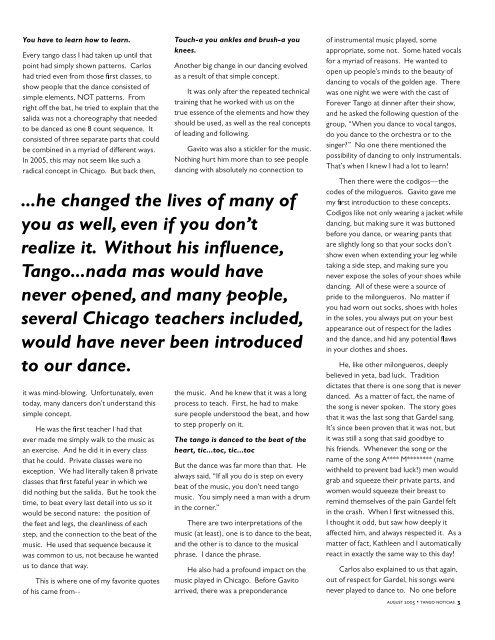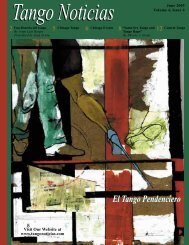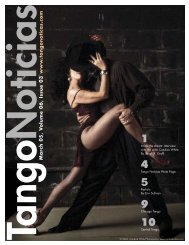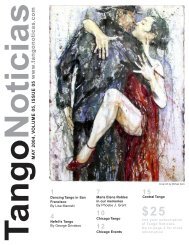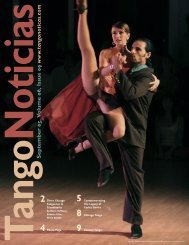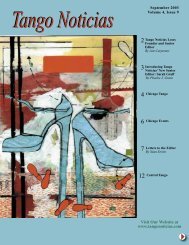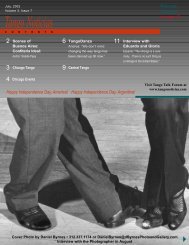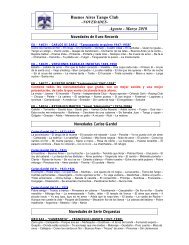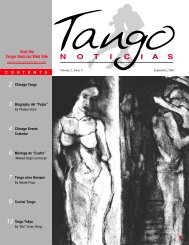in memoriam - info
in memoriam - info
in memoriam - info
- No tags were found...
You also want an ePaper? Increase the reach of your titles
YUMPU automatically turns print PDFs into web optimized ePapers that Google loves.
You have to learn how to learn.Every tango class I had taken up until thatpo<strong>in</strong>t had simply shown patterns. Carloshad tried even from those first classes, toshow people that the dance consisted ofsimple elements, NOT patterns. Fromright off the bat, he tried to expla<strong>in</strong> that thesalida was not a choreography that neededto be danced as one 8 count sequence. Itconsisted of three separate parts that couldbe comb<strong>in</strong>ed <strong>in</strong> a myriad of different ways.In 2005, this may not seem like such aradical concept <strong>in</strong> Chicago. But back then,it was m<strong>in</strong>d-blow<strong>in</strong>g. Unfortunately, eventoday, many dancers don’t understand thissimple concept.He was the first teacher I had thatever made me simply walk to the music asan exercise. And he did it <strong>in</strong> every classthat he could. Private classes were noexception. We had literally taken 8 privateclasses that first fateful year <strong>in</strong> which wedid noth<strong>in</strong>g but the salida. But he took thetime, to beat every last detail <strong>in</strong>to us so itwould be second nature: the position ofthe feet and legs, the cleanl<strong>in</strong>ess of eachstep, and the connection to the beat of themusic. He used that sequence because itwas common to us, not because he wantedus to dance that way.This is where one of my favorite quotesof his came from--Touch-a you ankles and brush-a youknees.Another big change <strong>in</strong> our danc<strong>in</strong>g evolvedas a result of that simple concept.It was only after the repeated technicaltra<strong>in</strong><strong>in</strong>g that he worked with us on thetrue essence of the elements and how theyshould be used, as well as the real conceptsof lead<strong>in</strong>g and follow<strong>in</strong>g.Gavito was also a stickler for the music.Noth<strong>in</strong>g hurt him more than to see peopledanc<strong>in</strong>g with absolutely no connection to...he changed the lives of many ofyou as well, even if you don’trealize it. Without his <strong>in</strong>fluence,Tango...nada mas would havenever opened, and many people,several Chicago teachers <strong>in</strong>cluded,would have never been <strong>in</strong>troducedto our dance.the music. And he knew that it was a longprocess to teach. First, he had to makesure people understood the beat, and howto step properly on it.The tango is danced to the beat of theheart, tic...toc, tic...tocBut the dance was far more than that. Healways said, “If all you do is step on everybeat of the music, you don’t need tangomusic. You simply need a man with a drum<strong>in</strong> the corner.”There are two <strong>in</strong>terpretations of themusic (at least), one is to dance to the beat,and the other is to dance to the musicalphrase. I dance the phrase.He also had a profound impact on themusic played <strong>in</strong> Chicago. Before Gavitoarrived, there was a preponderanceof <strong>in</strong>strumental music played, someappropriate, some not. Some hated vocalsfor a myriad of reasons. He wanted toopen up people’s m<strong>in</strong>ds to the beauty ofdanc<strong>in</strong>g to vocals of the golden age. Therewas one night we were with the cast ofForever Tango at d<strong>in</strong>ner after their show,and he asked the follow<strong>in</strong>g question of thegroup, “When you dance to vocal tangos,do you dance to the orchestra or to thes<strong>in</strong>ger?” No one there mentioned thepossibility of danc<strong>in</strong>g to only <strong>in</strong>strumentals.That’s when I knew I had a lot to learn!Then there were the codigos—thecodes of the milogueros. Gavito gave memy first <strong>in</strong>troduction to these concepts.Codigos like not only wear<strong>in</strong>g a jacket whiledanc<strong>in</strong>g, but mak<strong>in</strong>g sure it was buttonedbefore you dance, or wear<strong>in</strong>g pants thatare slightly long so that your socks don’tshow even when extend<strong>in</strong>g your leg whiletak<strong>in</strong>g a side step, and mak<strong>in</strong>g sure younever expose the soles of your shoes whiledanc<strong>in</strong>g. All of these were a source ofpride to the milongueros. No matter ifyou had worn out socks, shoes with holes<strong>in</strong> the soles, you always put on your bestappearance out of respect for the ladiesand the dance, and hid any potential flaws<strong>in</strong> your clothes and shoes.He, like other milongueros, deeplybelieved <strong>in</strong> yeta, bad luck. Traditiondictates that there is one song that is neverdanced. As a matter of fact, the name ofthe song is never spoken. The story goesthat it was the last song that Gardel sang.It’s s<strong>in</strong>ce been proven that it was not, butit was still a song that said goodbye tohis friends. Whenever the song or thename of the song A**** M******** (namewithheld to prevent bad luck!) men wouldgrab and squeeze their private parts, andwomen would squeeze their breast torem<strong>in</strong>d themselves of the pa<strong>in</strong> Gardel felt<strong>in</strong> the crash. When I first witnessed this,I thought it odd, but saw how deeply itaffected him, and always respected it. As amatter of fact, Kathleen and I automaticallyreact <strong>in</strong> exactly the same way to this day!Carlos also expla<strong>in</strong>ed to us that aga<strong>in</strong>,out of respect for Gardel, his songs werenever played to dance to. No one beforeaugust 2005 • tango noticias 3


